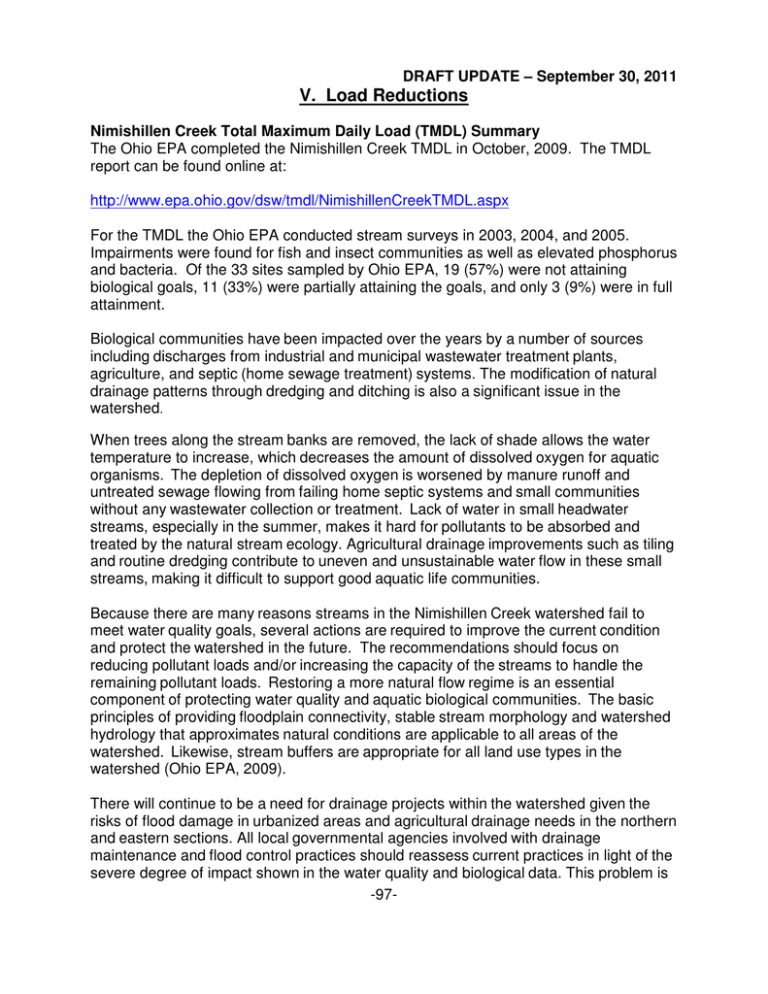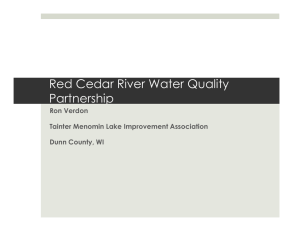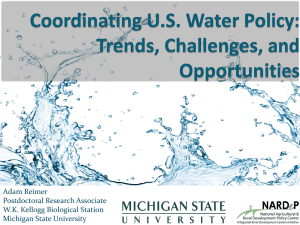V. Load Reductions
advertisement

DRAFT UPDATE – September 30, 2011 V. Load Reductions Nimishillen Creek Total Maximum Daily Load (TMDL) Summary The Ohio EPA completed the Nimishillen Creek TMDL in October, 2009. The TMDL report can be found online at: http://www.epa.ohio.gov/dsw/tmdl/NimishillenCreekTMDL.aspx For the TMDL the Ohio EPA conducted stream surveys in 2003, 2004, and 2005. Impairments were found for fish and insect communities as well as elevated phosphorus and bacteria. Of the 33 sites sampled by Ohio EPA, 19 (57%) were not attaining biological goals, 11 (33%) were partially attaining the goals, and only 3 (9%) were in full attainment. Biological communities have been impacted over the years by a number of sources including discharges from industrial and municipal wastewater treatment plants, agriculture, and septic (home sewage treatment) systems. The modification of natural drainage patterns through dredging and ditching is also a significant issue in the watershed. When trees along the stream banks are removed, the lack of shade allows the water temperature to increase, which decreases the amount of dissolved oxygen for aquatic organisms. The depletion of dissolved oxygen is worsened by manure runoff and untreated sewage flowing from failing home septic systems and small communities without any wastewater collection or treatment. Lack of water in small headwater streams, especially in the summer, makes it hard for pollutants to be absorbed and treated by the natural stream ecology. Agricultural drainage improvements such as tiling and routine dredging contribute to uneven and unsustainable water flow in these small streams, making it difficult to support good aquatic life communities. Because there are many reasons streams in the Nimishillen Creek watershed fail to meet water quality goals, several actions are required to improve the current condition and protect the watershed in the future. The recommendations should focus on reducing pollutant loads and/or increasing the capacity of the streams to handle the remaining pollutant loads. Restoring a more natural flow regime is an essential component of protecting water quality and aquatic biological communities. The basic principles of providing floodplain connectivity, stable stream morphology and watershed hydrology that approximates natural conditions are applicable to all areas of the watershed. Likewise, stream buffers are appropriate for all land use types in the watershed (Ohio EPA, 2009). There will continue to be a need for drainage projects within the watershed given the risks of flood damage in urbanized areas and agricultural drainage needs in the northern and eastern sections. All local governmental agencies involved with drainage maintenance and flood control practices should reassess current practices in light of the severe degree of impact shown in the water quality and biological data. This problem is -97- DRAFT UPDATE – September 30, 2011 not unique to the Nimishillen Creek watershed. Alternative methods of ditching and stream channel management can be implemented to achieve the necessary drainage with less environmental impact. Local planning and zoning will need to look at better ways of integrating watershed stewardship and storm water management into land use decision making. Good planning decisions early will help to minimize long term consequences and expenses. TMDLs Developed In the Nimishillen Creek Watershed, the Ohio EPA developed TMDLs for total phosphorus (TP), pathogens (bacteria), habitat, and sediment. The pathogen TMDL addresses impairment of recreational uses in the basin. The sediment, pathogens, and total phosphorus TMDLs deal with impairments to aquatic life. For each of these sources of impairment, the TMDL establishes an existing load, the load need to no longer be impaired, and a percent reduction needed. The TMDL shows the load reduction needs for each HUC 12 subwatershed that is not in attainment. TMDL Load Reductions Phosphorus The lower section of the East Branch Nimishillen Creek and all of the mainstem Nimishillen Creek do not meet their aquatic life use designation of warm water habitat. Nutrients are a cause of impairment in all of these sites with major municipal wastewater treatment plants and urban runoff as the main sources of these nutrients. Times of low stream flow in warmer months are believed to be the critical condition in which these nutrients cause the most detriment to aquatic life. This is generally based on the fact that the nutrient rich discharge from municipal wastewater treatment plants on both East Branch Nimishillen Creek and the mainstem dominates stream flow during these events. Nutrients, and dissolved oxygen (DO), are assessed using the QUAL2K model, version 2.04 (Ohio EPA, 2009). Table V-1 show the TMDL and load allocations for total phosphorus in Nimishillen Creek’s East Branch and Mainstem. -98- DRAFT UPDATE – September 30, 2011 Table V-1: TMDL and Allocations of Total Phosphorus Design Flow (MGD) Phosphorus WLA/LA at Sources Conc. (mg/l) Load (kg/day) 2.00 2.74 0.30 - 1.00 0.16 0.08 - 7.56 1.66 0.09 0.11 39.00 0.16 1.67 3.50 - 0.40 1.00 0.27 0.27 - 59.05 0.60 1.70 3.58 1.34 East Branch Nimishillen Creek Louisville WWTP Republic Steel Corp. 010 Outfall Republic Steel Corp. Other Outfalls Nonpoint Sources Nimishillen Creek Canton WPCF Canton Water Dept. NE Plan Marathon Ashland Petroleum Timken Company Nonpoint Sources Phosphorus Loads at 1 Compliance Points (kg/day) TMDL 2 2 2 WLA LA 2.34 2.315 0.026 21.78 21.368 0.416 1 Compliance point at RM 0.05 on East Branch Nimishillen Creek and at RM 0.62 on Nimishillen Creek. The allocations for the Nimishillen Creek compliance point reflect the sum of the loads contributed in Nimishillen Creek. The allocations for the East Branch compliance point reflect the sum of the loads contributed in East Branch. The loads contributed upstream of the East Branch compliance point are included in the model and are reflected in the Nimishillen Creek compliance point. 2 The loads contributed to the streams decay and assimilate so that the TMDL is met at both compliance points. Abbreviations: MGD=million Gallons per Day; WLA = Waste Load Allocation; LA = Load Allocation; mg/l = milligrams per liter; kg/day = kilograms per day; WWTP = wastewater treatment plan; WPCF = water pollution control facility; Conc. = concentration Source: Nimishillen Creek TMDL, Ohio EPA, 1999. During low flow periods, effluents from point sources are rich with phosphorus resulting in noncompliance with Ohio EPA’s permits limits. Therefore, the TMDL recommends that all wastewater treatment plants with a designed flow greater than 100,000 gallons per day limit their total phosphorus discharge to 1.0 mg/l. According to the Ohio EPA, this reduction should provide enough in stream nutrient production (approximately 60 percent) to improve aquatic life throughout the watershed while imposing achievable permit limits on dischargers (Ohio EPA, 2009). Pathogens (Bacteria) The TMDL states that recreation use impairments from pathogens in the Nimishillen Creek Watershed are primarily from failing home sewage treatment systems (HSTS) and agriculture from both crops and livestock. Wildlife is believed to make a relatively small contribution to the pathogen load. Urban areas contributions to some extent attributed to storm water runoff and failing HSTS. The recreational impact is from both point and nonpoint sources of pollution. Table V-2 show the existing load, TMDL, waste load allocations, and the percent reduction needed to reach attain water quality standards (Ohio EPA, 2009). -99- DRAFT UPDATE – September 30, 2011 Table V-2: Total Existing Load, TMDL, and Allocations of Fecal Coliform Loads (for the recreation season) 12-digit HUC Upper Middle Branch Nim. Cr. East Branch Nim. Cr. West Branch Nim. Cr. 2 Sherrick Run Lower Mainstem Nim. Cr. -04 -02 -03 -05 -06 1 Subwatershed 3 -1 3 PS Existing Loads NPS Total TMDL 1 Allocations WLA LA % Reduction 467.8 141.4 609.2 74.8 87.7 0.09 74.7 1404.0 286.3 1690.3 164.2 90.3 1.6 162.6 2246.7 41.1 2287.8 143.6 93.7 113.3 30.4 560.3 6.03 566.4 35.1 93.8 29.1 6.03 664.3 2.49 666.8 94.6 85.5 92.1 2.49 -1 cfu * 10 * season (for cfu * 10 * day divided each value by 138) Sherrick Run is only part of the 12-digit HUC Source: Nimishillen Creek TMDL, Ohio EPA, 2009 2 Tables V-3 and V-4 further breakdown the load reductions from point and nonpoint sources, respectively. Table V-3: Point Source Fecal Coliform Loads. These Include Existing, Percent Reduction Required, and Wasteload Allocation (WLA) by Source 1 12-digit HUC Subwatershed -04 Upper Middle Branch Nim. Cr. -02 -03 -05 -06 East Branch Nim. Cr. West Branch Nim. Cr. 2 Sherrick Run Lower Mainstem Nim. Cr. Existing % Reduction Allocation Existing % Reduction Allocation Existing % Reduction Allocation Existing % Reduction Allocation Existing % Reduction Allocation 1 cfu * 103 * season-1 (for cfu * 103 * day-1 divided each value by 138) 2 Sherrick Run is only part of the 12-digit HUC Source: Nimishillen Creek TMDL, Ohio EPA, 2009 -100- Point Source Loads NPDES MS4 Discharger 0.08 0.015 0 24.2 0.08 0.011 1.38 0.36 0 30.2 1.38 0.25 0.20 0.78 0 0 0.20 0.78 0.01 0.05 0 0 0.01 0.05 24.82 0.07 0 0 24.82 0.07 HSTS 467.78 100 0 1402.2 100 0 2245.7 95.0 112.29 560.27 94.8 28.33 639.39 98.5 67.20 Total WLA 467.8 0.09 1404.0 1.6 2246.7 113.3 560.3 29.1 664.3 92.1 DRAFT UPDATE – September 30, 2011 Table V-4: Nonpoint Source Fecal Coliform Loads. These Include Existing, Percent Reduction Required, and Load Allocation (LA) by Source 1 12digit HUC Subwatershed -04 Upper Middle Branch Nim. Cr. -02 -03 Non-Point Source Loads East Branch Nim. Cr. West Branch Nim. Cr. 3 -05 Sherrick Run -06 Lower Mainstem Nim. Cr. Existing % Reduction Allocation Existing % Reduction Allocation Existing % Reduction Allocation Existing % Reduction Allocation Existing % Reduction Allocation 2 Cropland Pasture Forest Urban 31.44 24.2 23.85 65.20 30.2 45.49 12.96 0 12.96 4.37 0 4.37 0.77 0 0.77 66.74 24.2 50.61 166.64 30.2 166.27 17.01 0 17.01 1.29 0 1.29 0.64 0 0.64 0.18 0 0.18 0.72 0 0.72 0.24 0 0.24 0.32 0 0.32 0.98 0 0.98 0.11 24.2 0.08 0.12 30.2 0.09 0.17 0 0.17 0.05 0 0.05 0.09 0 0.09 Cattle in Stream 42.91 100 0 53.64 100 0 10.73 100 0 0 0 0 0 Total LA 141.4 74.7 286.3 162.6 41.1 30.4 6.03 6.03 2.49 2.49 1 cfu * 103 * season-1 (for cfu * 103 * day-1 divided each value by 138) 2 This is non-MS4 Urban 3 Sherrick Run is only part of the 12-digit HUC Source: Nimishillen Creek TMDL, Ohio EPA, 2009 Habitat Habitat alteration is a cause of impairment throughout the Nimishillen Creek Watershed. Poor habitat quality is an environmental condition, rather than a pollutant load, so development of a load-based TMDL to address this cause of impairment is not possible. However, the Qualitative Habitat Evaluation Index (QHEI) is a tool that provides a numeric value, which is assigned to a particular stream segment based on the quality of its habitat. The QHEI evaluates six general aspects of physical habitat that include channel substrate, instream cover, riparian characteristics, channel condition, pool/riffle quality, and gradient and drainage area (Ohio EPA, 2009). The analysis of the QHEI components as they relate to fish community scores by the Ohio EPA led to the development of a list of attributes that are associated with degraded communities. These attributes are modifications of natural habitat and are listed in Table V-5. The Ohio EPA further divided modified attributes into high influence and moderate influence attributes based on the statistical strength of the relationships. The presence of these attributes can strongly influence the characteristics of the fish communities, and the QHEI score itself may not reflect this effect. High influence modified attributes are particularly detrimental. The presence of one is likely to result in impairment, and two will likely preclude a site from achieving aquatic biology standards (Ohio EPA, 2009). -101- QHEI Category QHEI Score DRAFT UPDATE – September 30, 2011 Table V-5: QHEI Modified Attributes Modified Attributes High Influence Moderate Influence - Channelized or No Recovery - Silt/Muck Substrate - Low Sinuosity - Sparse/No Cover - Max Pool Depth < 40 cm (Wadable streams only) - Recovering Channel - Sand Substrate (boat sites) - Hardpan Substrate Origin - Fair/Poor Development - Only 1-2 Cover Types - No Fast Current - High/Moderate Embeddedness - Ext/Mod Riffle Embeddedness - No Riffle Source: Nimishillen Creek TMDL, Ohio EPA, 2009. The habitat TMDL equation presented in Table V-6 reflects the relationship between the QHEI score, modified attributes and fish community performance. The TMDL is based upon a total score of three (3), and is the sum of three component scores each worth one point (Ohio EPA, 2009). Sites with a Habitat TMDL score below three are considered impaired. -102- DRAFT UPDATE – September 30, 2011 QHEI Score TMDL Targets Stream (12Digit HUC) Middle Branch Nim. Cr. (-04) Swartz Ditch (-04) Middle Branch Nim. Cr. (-01) Nimishillen Cr. (-01) East Branch Nim. Cr. (-02) West Branch Nim. Cr. (-03) McDowell Ditch (-03) Zimber Ditch (-03) Nimishillen Creek (-05) Sherrick Run (-05) Nimishillen Creek (-06) > 60 = 1 point Table V-6: Habitat TMDL Allocations # of High Total # of Modified Influence Attributes Attributes < 2 = 1 point TMDL 3 points < 5 = 1 point River Mile QHEI Score # of High Influence Attributes Total # of Modified Attributes QHEI Score 13.6 28 5 10 0 0 0 0 1.2 31.5 3 8 0 0 0 0* 10.4 3.8 14.2/ 14.3 52 56 2 1 8 7 0 0 0 1 0 0 0 1 71.5 1 7 1 1 0 2 60.5 1 7 1 1 0 2 60.5 1 4 1 1 1 3 47 3 9 0 0 0 0 58.5 1 6 0 1 0 1 77 0 1 1 1 1 3 74 0 3 1 1 1 3 69 1 5 1 1 0 2 67.5 1 5 1 1 0 2* 2.4 60 1 5 1 1 0 2 11.1 68.5 1 5 1 1 0 2 0.1 78.5 0 0 1 1 1 3 9.9 6.8/ 6.7 2.7 79.5 0 6 1 1 0 2 78 0 3 1 1 1 3 78 0 3 1 1 1 3 0.1 10.5/ 10.4 9.3/ 9.0 4.6/ 4.7 3.2 0.4/ 0.3 0.1 1.9/ 1.8 Sub-Score High Total # Influence Modified Total Habitat Score * Note that these two streams are designated Modified Warmwater Habitat (MWH) Source: Nimishillen Creek TMDL, Ohio EPA, 2009. Sediment In the Nimishillen Creek watershed, three of Ohio EPA’s TMDL assessment areas have some type of sedimentation listed as a cause of impairment in addition to habitat alteration. In order to address this, Ohio EPA developed numeric targets for -103- DRAFT UPDATE – September 30, 2011 sediment based upon the QHEI metrics. The QHEI substrate, riparian characteristic, and channel metrics all evaluate stream attributes related to sediment. Each of these factors influences the degree to which sediment affects a stream, and cumulatively serves as its numeric target (Ohio EPA, 2009). The individual components of the sediment TMDL are QHEI metric scores for substrate, channel and riparian. These metric target scores are based on the same associations made between QHEI and aquatic biology results as explained in the habitat TMDL above. Table V-7 show the minimum scores expected for the sediment TMDL (Ohio EPA, 2009). TMDL Target for Warm Water Habitat (WWH) Table V-7: Sediment TMDL QHEI Categories Total TMDL Substrate Channel Riparian Score Allocations > 13 > 14 >5 32 Existing Scores QHEI Scores Stream (12Digit HUC) Middle Branch Nim. Cr. (-04) Middle Branch Nim. Cr. (-01) West Branch Nim. Cr. (-03) Total Sediment Score Percent Deviation from Target Main Impairment Category 3 8 75.0 Substrate 8 6.5 20 37.5 Substrate 14 6.5 32.5 - Substrate River Mile Substrate Channel Riparian 13.6 1 4 10.4 5.5 10.5 12 Source: Nimishillen Creek TMDL, Ohio EPA, 2009. Nimishillen Creek TMDL Important “Fixes” • Include phosphorus effluent limits of 1 mg/l in NPDES permits to wastewater treatment plants • Improve erosion and sediment controls in all areas Practice conservation tillage on row crop farms Install filter strips along all agricultural tributaries Install storm water controls in developing areas and construction sites Establish and protect vegetation along stream banks • Develop better storm water management – reduce dependency on “ditching” Remedy current methods of ditching, which are destructive to habitat, exacerbate downstream flooding, and are harmful to aquatic life and water quality Integrate a holistic view of storm water and its management to provide long-term cost effective solutions • Eliminate pervasive bacteria problems Improve planning for environmentally sustainable manure and nutrient management agricultural facilities Reduce and correct home sewage treatment system failures -104-





